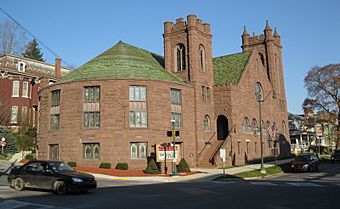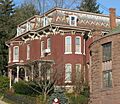Brookville Presbyterian Church and Manse facts for kids
Quick facts for kids |
|
|
Brookville Presbyterian Church and Manse
|
|
|
U.S. Historic district
Contributing property |
|

Brookville Presbyterian Church, November 2009
|
|
| Location | White and Main Sts., Brookville, Pennsylvania |
|---|---|
| Area | 0.6 acres (0.24 ha) |
| Built | 1890, 1904-1905 |
| Architect | Robinson & Winkler; John H. Carr |
| Architectural style | Second Empire, Romanesque |
| NRHP reference No. | 82001538 |
| Added to NRHP | November 26, 1982 |
Brookville Presbyterian Church and Manse is a special historic place in Brookville, Pennsylvania. It includes a beautiful church and a house called a manse. Both buildings are found at White and Main Streets in Jefferson County, Pennsylvania. They are important parts of the town's history.
Contents
Discovering the Church Building
The church building was constructed between 1904 and 1905. It is made from a reddish-brown stone called Hummelstown brownstone. The church has a unique style known as Richardsonian Romanesque. This style often uses heavy stone and round arches.
Church Features and Design
The church has two main entrances. Each entrance is set back in a covered porch area, which is called a loggia. There is also a tall, square bell tower that stands out. Inside, the church uses a special layout called the Akron plan. This design helps everyone see and hear during services.
Exploring the Manse
The manse is the house next to the church. It was built earlier, in 1890. This house is made of brick and has a style called Second Empire architecture. This style was popular in the late 1800s.
Manse Details and Style
The manse has some interesting features. It has two large, two-story bay windows that stick out from the building. The roof is a special type called a mansard roof. This roof has four sides, each with two slopes. There is also an open porch where people can relax.
A Place of Historical Importance
Both the Brookville Presbyterian Church and Manse are very important. They were added to the National Register of Historic Places in 1982. This means they are recognized as significant historical sites in the United States. The church and manse are also part of the larger Brookville Historic District. This district protects many old and important buildings in the town.
Images for kids





